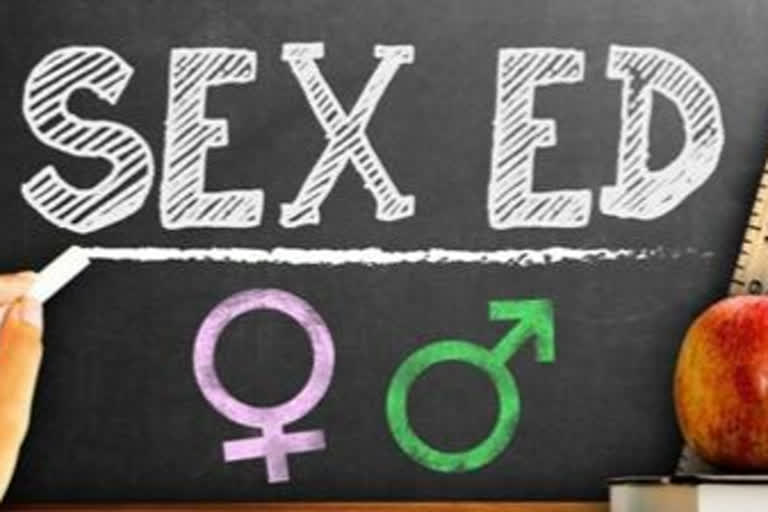Hyderabad: While there has been drastic social transformation in India in the past few decades and increasing adaptability, liberalization of social mores and hardwired attitudes, a lot still remains to be done when it comes to sex education.
The shutdown of schools due to COVID-19 pandemic has adversely affected whatever modicum of sex education was available. Teacher-student one-on-one and classroom group interaction has almost come to a halt, and students feel anxious and stressed by being confined at their homes and gazing at their screens for lectures. Absence of physical interaction with their peer group, classmates and the spirit of inquisitively grasping anything new is now more difficult than ever for teenagers. Another issue is that with students spending more time online, there is an enhanced risk of cyber bullying and online harassment. Without a proper mechanism for sex education, this will tend to get worse.
In the age of hyper internet connectivity and pandemic-induced study-at-home, there has to be a change in both the approach and the method. The blind spots in the conventional approach have to be fixed so as to make sex education truly inclusive, progressive, gender-neutral, and not divorced from the prevailing environment.
It is only due to the woeful lack of sex education that in large parts of the country there is a little awareness about what constitutes sexual harassment and violation of bodily autonomy. The gap between consent, infringement, and rape is not understood, and the stigmatization only pushes these instances under the rug, which only emboldens the perpetrators. As per a study by Indian Ministry of Women and Child Development, carried out by UNICEF and Prayas, an NGO, a shocking 53% of children between the ages of 5 and 12 have been sexually abused. In most of the cases, the offenders were close relatives of the victims, and more than half of all these cases go unreported.
Need of a broader outlook
Mostly, sex education in India is considered synonymous with teenage pregnancies and HIV/ AIDS. Even menstruation is only perfunctorily addressed. There is a need for a much broader understanding of the topic and attuning its as per gender identity, orientation and diversity.
Another issue is that despite the overreaching consensus and the imperative for it as a subject, there are still a lot of schools and other institutions that do not have any form of sex education in their curriculum. According to a report by ‘Youth Coalition for Sexual and Reproductive Rights’, most schools, private and public affiliated state boards of secondary education don’t have any form of sexuality education in their curriculum’.
Also read: India to introduce machine learning in schools: Education Minister
The government of India initiated ‘Adolescent Education Program’ (AEP) in 2007 in collaboration with National AIDS Control Organization (NACO) and United Nations Children’s Fund (UNICEF). The same year it was initiated by the government across all states. While the MHRD deemed the initiative as crucial to ‘empower young people with accurate, age appropriate and culturally relevant information, promote healthy attitudes and develop skills to enable them to respond to real life situations in positive ways’, it was not implemented and subsequently banned by over 12 states who red flagged the content as 'inappropriate'.
In spite of the changing social and cultural sensibilities, there are still connotations of taboo with the terms 'sex' and 'sexuality'. Due to the complete lack of an honest, reasoned, healthy and open discourse on this topic, as a result it continues to be enveloped in embarrassment and denial.
Truly comprehensive approach
National Health Policy 2020 overlooks adolescent sex education, even though it mentions the need for physical health and 'gender sensitivity'.
There is a need for creating a pool of trainers who can comfortably move on from a preventive pedagogy to a rights-based approach to imparting and scaling comprehensive sex education in a language that is easily understood by the masses, particularly the most vulnerable adolescents, who do not have access to formal education.
A Program needs to be devised that is holistic, provides opportunities for self-development, and includes a judicious mix of interactive activities with fun and learning. Interventions should be designed for school authorities, teachers, community leaders and parents, to get their buy-in for implementing it, and for enabling them to adopt positive, non-judgmental and supportive roles to guide adolescents and also to equip some of them as sex education trainers. NGOs/CBOs can be roped in for the purpose.
In keeping up with the current times, the use of digital media and web-based interfaces can also be explored to facilitate sex education
The internet and digital media can enable private, personalized and easily accessible answers to critical questions about sexuality and relationships that may not be otherwise forthcoming. These mediums can also provide sex educators an avenue to reach young people directly via innovative technologies, websites, messaging apps and social media platforms.



